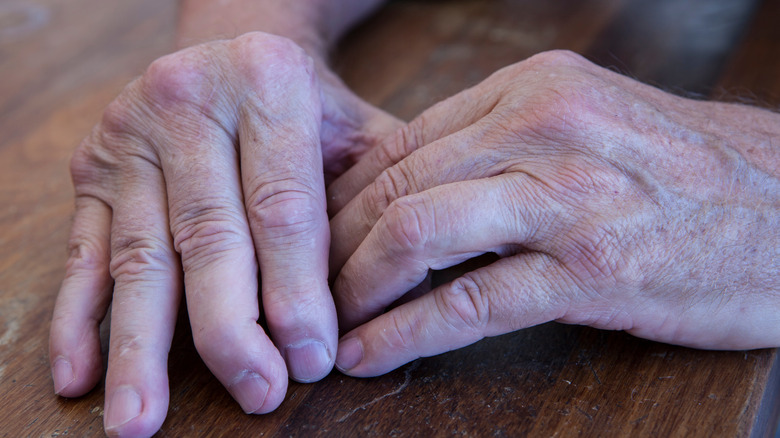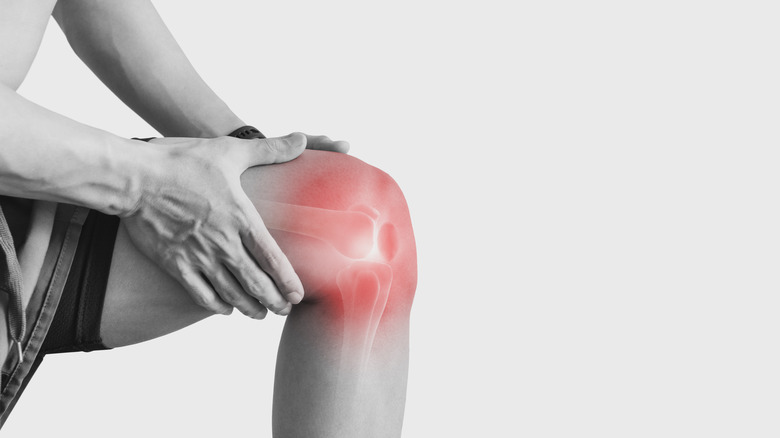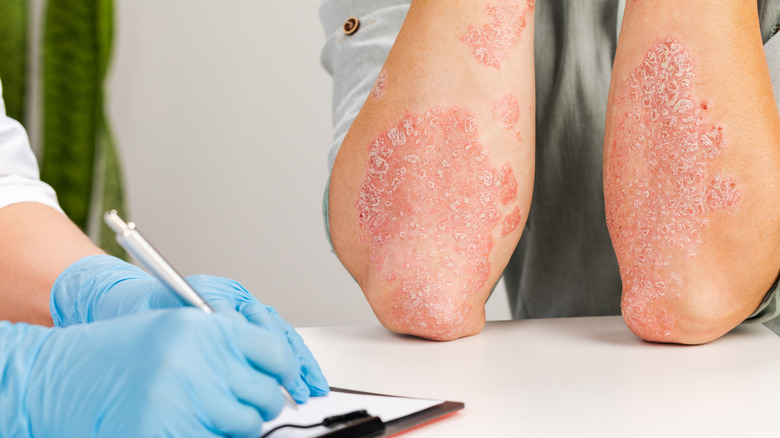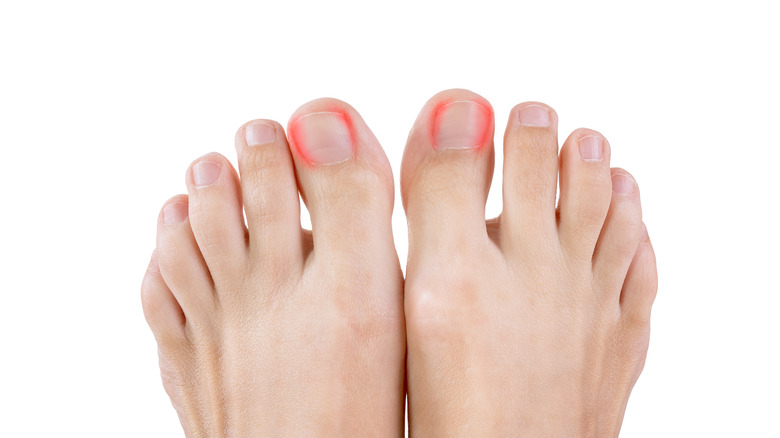The 5 Types Of Psoriatic Arthritis
Psoriasis is a common long-term skin disease that has no known cure. It typically causes red, itchy, scaly patches on the skin that come and go in cycles (via the Mayo Clinic). For some people, psoriasis is also accompanied by pain in the joints, which also comes and goes in cycles just like the skin rashes. This condition is known as psoriatic arthritis. It can affect many different parts of the body, and the pain can be anywhere from mild to severe, according to the Mayo Clinic. As with psoriasis in general, there is no known cure for psoriatic arthritis as it is believed to be caused by a malfunction in your body's own immune system.
Psoriatic arthritis affects up to 30 percent of people with psoriasis, or 1 million Americans annually (via WebMD). It manifests in different ways in different people. In fact, there are five distinct types of psoriatic arthritis, including distal interphalangeal predominant, asymmetric oligoarticular, symmetric polyarthritis, spondylitis, and arthritis mutilans. Each one has its own symptoms.
Asymmetric psoriatic arthritis
Unlike other forms of arthritis that are often symmetrical, meaning that they usually affect the same joints on both sides of the body, asymmetric psoriatic arthritis is characterized by the fact that it only affects one side of the body instead of matching joints (via WebMD). It also tends to affect only a small number of joints, usually just one to three, unlike other forms of psoriatic arthritis that may involve more parts of the body.
Because of its limited reach, asymmetric psoriatic arthritis is considered milder than other forms of the disease (via Verywell Health). It also tends to affect larger joints, like the knees, more than smaller ones, but sometimes also affects a hand or foot as well. Stiffness and pain on one side of the body, especially in the morning, that is usually accompanied by breakouts of scaly, itchy, red skin, are the main symptoms of asymmetric psoriatic arthritis.
According to Verywell Health, treating asymmetric psoriatic arthritis is similar to treating other kinds of psoriatic arthritic conditions and may involve disease-modifying antirheumatic drugs (DMARDs) or corticosteroids.
Symmetric psoriatic arthritis
Unlike asymmetric psoriatic arthritis, symmetric psoriatic arthritis affects both sides of the body at the same time and usually involves matching, or mirror image, joints. If one knee, or one finger, experiences the pain and inflammation associated with this condition, the opposite corresponding joint does as well (via Medical News Today). According to a 2012 article published in the journal Clinical Reviews in Allergies & Immunology, 50-60 percent of people with psoriatic arthritis in more than four joints display this symmetrical quality.
Symmetric psoriatic arthritis can affect any joint in the body, and the truth is that asymmetric psoriatic arthritis typically evolves into symmetric psoriatic arthritis as the disease progresses and symptoms worsen (via Verywell Health). Treatment is essential to slow the progression of symmetric psoriatic arthritis, and like asymmetric psoriatic arthritis, usually involves the use of DMARDs, which protect joints from damage, or corticosteroids, which attempt to control inflammation.
Psoriatic spondylitis
Psoriatic spondylitis is a specific type of psoriatic arthritis that develops in the spine or the pelvis, and may also cause inflammation in the shoulders, hips, and knees. Spondylitis refers to arthritis that occurs in the back, sometimes fusing and becoming rigid, which is known as ankylosis (via the Cleveland Clinic). According to Medical News Today, people who experience psoriatic spondylitis often have trouble moving or bending their back without suffering great pain, a symptom that just gets worse as the condition progresses.
A 2017 study published in the journal Annals of Rheumatic Diseases found that 24 percent of people who develop spondylitis also have psoriasis. Treatment for psoriatic spondylitis often includes physical therapy and stretching exercises as well as attempts to control posture (via Verywell Health). If the disease progresses, DMARDs, which protect joints and bones from damage, and tumor necrosis factor (TNF) inhibitors are often prescribed.
Distal interphalangeal predominant psoriatic arthritis
Also known as DIP, distal interphalangeal predominant psoriatic arthritis is a type of psoriatic arthritis that affects the joints of the fingers and toes closest to the nail (via WebMD). According to Medical News Today, distal interphalangeal joint pain is also a common feature of osteoarthritis.
According to Verywell Health, distal interphalangeal predominant psoriatic arthritis is one of the less common forms for psoriatic arthritis, accounting for under ten percent of all cases of the condition. There are a variety of treatments that medical professionals recommend for distal interphalangeal predominant psoriatic arthritis, like soaking hands in warm water, and maintaining cuticles in order to reduce skin injuries that may trigger symptoms.
While regular pain medications can be used to treat mild symptoms, cases of distal interphalangeal predominant psoriatic arthritis that progress to the point that they cause debilitating pain are usually treated with DMARDs or corticosteroid injections.
Psoriatic arthritis mutilans
Also known as "pencil in cup" deformity, psoriatic arthritis mutilans is the most severe form of psoriatic arthritis, but also happens to be the rarest, affecting less than five percent of the people who develop psoriatic arthritis (via WebMD). Those with psoriatic arthritis mutilans experience a strong auto-immune reaction that causes extreme inflammation in the fingers or toes which eventually leads to bone deterioration and loss. The end result is that fingers and toes become shorter.
According to Verywell Health, there appear to be some genetic predispositions to developing psoriatic arthritis mutilans, as well as lifestyle factors like excessive alcohol consumption, repetitive heavy lifting, smoking, and extreme stress. Both nonsteroidal anti-inflammatory drugs (NSAIDs), which help to decrease the intense pain associated with the condition, and corticosteroids, which attempt to reduce the inflammation, are often prescribed for psoriatic arthritis mutilans. A class of medications called biologics, which target your immune system and try to reduce the auto-immune response, are also used in serious cases.






